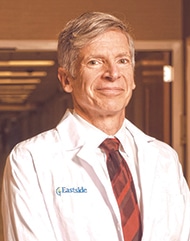
Q. If I have back pain, and my primary care physician sends me to the neurosurgeon, does that mean I am having surgery?
A. No. There are many causes of back pain, and most back pain gets better with conservative treatment. After a diagnosis is made from history, neurological examination, and imaging, I usually start with nonsurgical treatments including anti-inflammatory medications, physical therapy, and sometimes epidural steroid injections. Our bodies have an amazing capacity to heal themselves if we are patient. If these methods fail to provide relief, surgery may be necessary. Depending on the diagnosis, sometimes urgent surgery can be required to preserve nerve function, especially if there is weakness or bowel or bladder dysfunction.
Q. I am an athlete. If I have spinal surgery, will I be able to return to my sport?
A. Many of my patients are athletes. Being a marathon runner and weight lifter myself, I recognize the importance recreational sports have in the physical and emotional wellbeing of my patients. It is a priority for me whenever possible to select a treatment plan and surgical options that will most likely allow my athletic patients a chance to maximally improve and get back to their active lifestyle.
Q. Do neurosurgeons treat headaches?
A. Neurosurgeons treat headaches that have a structural basis such as brain tumors, a Chiari malformation (a congenital condition where a portion of the brain protrudes from the skull into the spinal canal), an obstruction of the spinal fluid pathways, or cranial nerve disorders such as trigeminal neuralgia, and many other conditions. However, many headaches such as migraines or tension headaches are not caused by a structural abnormality and are instead treated by a medical neurologist.
Q. I have a herniated lumbar disc and have been told I have sciatica. How long would recovery be if I had surgery to treat this condition?
A. When I operate on lumbar disc herniations, I typically make an incision that is just under 1 inch long. I remove the herniated portion of the disc using a microscope which allows for minimal disturbance of spinal tissues. The surgery takes approximately 1 hour. A band-aid is placed over the incision, and I have my patients walking 1 hour postoperatively. Patients either go home the same day or may stay overnight. Depending on the physical requirements of the job, patients may return to work in a few days.
Q. My cousin was recently diagnosed with a brain tumor. How should she select a neurosurgeon to treat it?
A. This is a very important decision. Not all neurosurgeons routinely operate on brain tumors, and some have more experience than others. It is important to ask your neurosurgeon how many brain tumor surgeries they have performed, how long they have been in practice, and how many surgeries they have performed on the specific type of tumor your cousin has. Some tumors are malignant and may not be cured with surgery. In these cases, technical skill and experience are essential to provide as complete a surgical resection as possible. This is proven to directly impact patient survival and quality of life. Other brain tumors may be benign and are curable with surgery; however, some benign tumors may be in dangerous locations. Having a technically skilled and experienced surgeon with a record of successful outcomes is vital.
Q. What sets you apart from other neurosurgeons?
A. In addition to training in neurosurgery, I simultaneously obtained a PhD in Experimental Neuroanatomy. This fostered a career-long interest in using anatomical knowledge to expand the boundaries of my brain tumor and general neurosurgery practice beyond what I was trained to do in neurosurgical residency. I started my career in academic practice with an interest in dangerous brain tumors occurring at the skull base. The first of my three decades of practice was primarily focused on brain tumors involving the skull base. I was privileged to serve as the Neurosurgical Director of the Center for Cranial Base Surgery at the University of Pittsburgh Medical Center. I was fortunate to have been hired by and served with my partner, Dr. Peter Jannetta who refined and popularized the microvascular decompression operation for trigeminal neuralgia and hemifacial spasm. This partnership with Dr. Jannetta provided valuable input and perspective to my practice as a young neurosurgeon with a strong interest in cranial nerve disorders. I spent a significant portion of my early career working to introduce and promote neurophysiological monitoring techniques during surgery to make surgery of the brain and spine safer. I was licensed by the FDA as an early investigator of magnetic stimulation of the brain to monitor the motor pathways under anesthesia. I developed a technique to electrically map the trigeminal nerve root at the brainstem during surgery. This directs the surgeon to the precise point on the nerve that corresponds to the site of the facial pain. I also developed a procedure used during surgery to electrically monitor parts of the vagus nerve to protect the fibers that supply the vocal cords. In addition I developed a formulation for a protein glue made from a patient’s own blood. This was widely used to prevent and treat cerebrospinal fluid leaks before commercial products were developed for this purpose. I was one of the early users of image-guidance technology in its developmental stages, and I collected data from large numbers of skull base tumor surgeries which helped to establish the role of this technology in brain tumor surgery. I was also the first neurosurgeon to use the digitized frameless stereotactic brain biopsy needle currently known as Stealth on the day the FDA approved this technique for use in the United States.
When Dr. Stechison isn’t working he spends time running, biking, boating, and at the gym. He enjoys playing the piano and performing along with his wife, a drummer, and their band Nervous Habit.
For more information, please call Neurosurgery Atlanta at (770) 809-3292 or visit NeurosurgeryAtlanta.com

